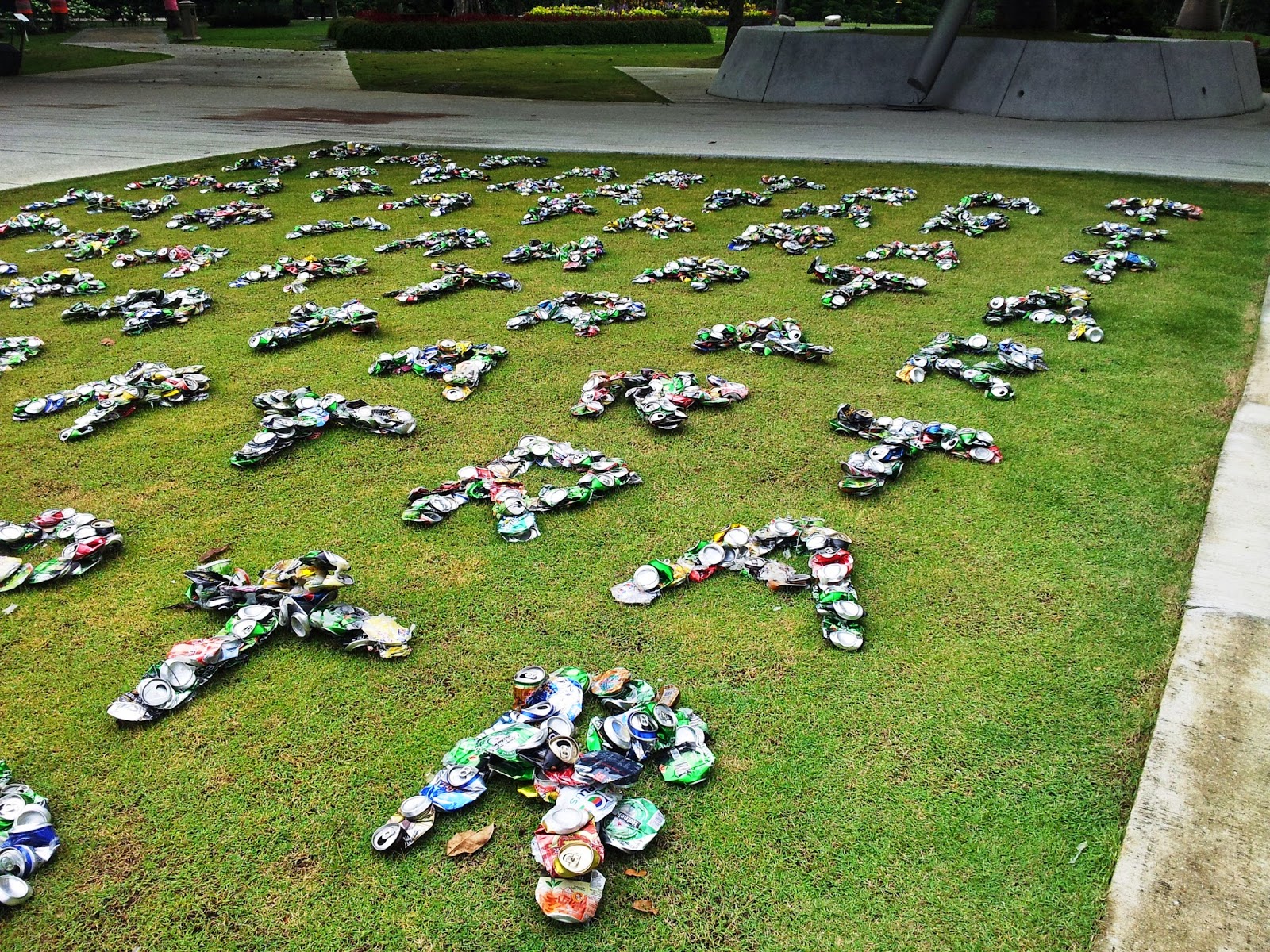Art in the Park 2014 @ Perdana Botanical Gardens
While still tackling issues like flash floods and homeless persons, the Kuala Lumpur City Hall demonstrates a recent progressive streak having initiated car-free Sunday mornings and supported the development of a KL bicycle map, then now endorsing a public art event at the former Taman Tasik Perdana. The inaugural Art in the Park festival’s detached objectives include “…to create a new cultural experience (…) and highlight Kuala Lumpur as Asia’s green capital and creative city”. Driving past the ASEAN Sculpture Garden amidst heavy traffic, and braving the drizzle after a hazy afternoon, the serene lake and its surrounding greenery prove immensely refreshing upon my visit. Approaching the park’s beautiful new canopy, aesthetic calm is interrupted by one 25-foot tall tower, and crushed tin cans littered on the grass beside it.
 |
| Installation view of Tey Beng Tze (FINDARS) - Rat in the Park (2014) |
The former structure by Multhalib Musa stands as a symbol of solidarity with Palestinians, its rusted yet precisely-cut steel a powerful visual marker representing the Israeli West Bank separation wall. Equally critical but more site-specific is Tey Beng Tze’s art/rat wordplay, the latter arrangement a reference to the city’s mining past, its flat presentation also a prompt to its dwellers about how inconspicuous trash is. These two works are rare examples of public art as critical interventions, and a delightful discovery among other displays – “…a scrap metal robot, a giant scarecrow, a bamboo house, an LED cloud and many other curiosities.” This event description in a newspaper write-up makes clear the level of art awareness among Malaysians, since enlarged plants at roundabouts are the benchmark for existing public art.
 |
| Installation view of Multhalib Musa - The Cornerstone of Peacelessness (2014) [picture from Kumpulan kejuruteraan kimpalan keluli karat kontemporari kuang Facebook page] |
“Found in KL” is a fitting theme, but upcycled constructs pair poorly with the historically aristocratic environment. Sabri Idrus’ windmill-doors are salvaged from Brickfields, and is a rotating device that belongs in Brickfields. Multhalib’s ‘Two Sides Two’ looks insignificant when displayed on open grass. Umibaizurah Mahir’s ceramic birds are perched too high to view underneath glaring daylight. 'Landed Nimbus' by Sharmiza Abu Hassan is reminiscent of the fairy lights along roads leading out of KL, its clever design easily missed when situated on higher ground. Foreign contributions fare no better – Marie Hugo’s ‘Pantun Forest’ is housed in too small a space for quiet appreciation; Handiwirman Saputra’s columns are not familiar shapes, resulting in one presentation missing a locally-relevant visual cue despite the thoughtful built-up.
 |
| Yeoh Lian Heng and Tsuji Lam (Lost Generation Space) - Gerai Gerak Seni (2014) [more pictures from Yeoh Lian Heng's Facebook page] |
Interacting with the public is Lisa Foo’s giant scarecrow “made from leaves, twigs and branches collected at Lake Garden itself”, a wonderful attraction that hopefully stays in place beyond the festival end date. Yeoh Lian Heng and Tsuji Lam’s ‘Gerai Gerak Seni’ also draws the crowd with pastel coloured carts, its exhibition of old photographs, printed vignettes, and art catalogues, effectively engaging the audience. Tyre swings and makeshift pondoks left over from a children’s workshop resemble one natural playground, which contrasts sharply with the bright plastic slides nearby. Beside that workspace are badminton racquets and pink shuttlecocks on a tree trunk, made by two young artists. ‘Sarang’ shows how public art is best embedded into its surroundings, especially when the beauty of a vast natural landscape, easily subdues man-made creations within a city park.
 |
| Installation view of Lisa Foo - Walk in the Park (2014) |
As the counterpoint to private art, the term public art is grossly misleading, considering that religious sculptures and political murals form the history of public art. These tokens of power require patronage, evident from the list of corporate sponsors for this event, as installation and maintenance budgets have to be factored into such commissions. The festival director quotes Hong Kong and Singapore as having more mature contemporary art scenes and public sculptures, unsurprising given that these two islands boast high income inequality. In a city where its denizens understand public spaces as air-conditioned malls owned by local tycoons, art in the park remains a far-reaching concept for many. Public art that encourage audience participation or photo ops are useful to increase art awareness, but its status as a technocratic tool cannot be dispelled.
 |
| Art in the park? |
“Public art is not a substitute for urban renewal or social work, although projects may address or include such functions. Public art ideally creates better places and provides enjoyment, insight, and maybe even hope to its participants, viewers, and users. But it cannot correct deeper problems stemming from widespread unemployment and poverty, the neglect of public education and healthcare, and all the other social ills so glaringly ignored at the moment. Yet these unreasonable expectations are often implicit or imbedded in the commissioning of public art.”
- Public art and urban regeneration: advocacy, claims and critical debates; Hall, T. and Robertson, I. (2001); Landscape Research, Vol. 26, No. 1: 5 - 26

Comments
Post a Comment